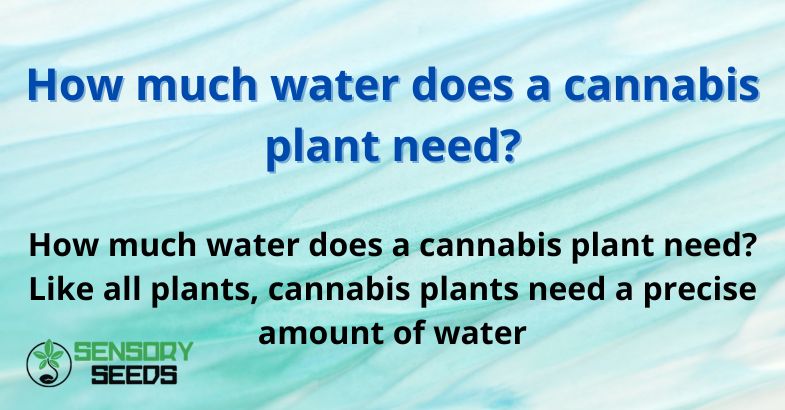Published on: 28/06/2024
How much water does a cannabis plant need? Like all plants, cannabis plants need a precise amount of water
Water is one of the elements that most influences a plant’s growth. The dosage and frequency of irrigation can determine the quality and quantity of the harvest.
However, the water requirements of cannabis can vary significantly depending on the stage of growth, the type of substrate used and the environmental conditions. Understanding these variables is crucial to ensuring a successful cultivation.
In this article, we will explore the importance of water in cannabis cultivation, providing details on optimal dosages and frequencies.
The role of water
Water plays a vital role in numerous physiological processes in cannabis. It is essential for photosynthesis, transpiration, nutrient transport and cell growth. Without an adequate supply of water, cannabis plants cannot grow properly, develop high-quality flowers or produce cannabinoids in optimal quantities.
During photosynthesis, water is a key component. A lack of water can reduce photosynthetic efficiency, impairing plant growth. In addition, through transpiration, water evaporates from the leaves, creating an updraft that allows the transport of nutrients from the soil to the leaves and flowers. Finally, water dissolves nutrients in the soil, making them available for uptake by the roots.
Water dosage at different growth stages
The water requirements of cannabis vary depending on the growth phase the plants are in. It is important to adapt the water dosage to meet these specific needs.
Read also: What are the growth phases of the cannabis plant?


Germination phase
During germination, cannabis seeds require a moist but not excessively wet environment. Water is essential to activate the enzymes necessary for initial growth. An atomiser can be used to keep the substrate moist without distorting it, with an ideal water temperature of around 20-25°C.
Vegetative phase
In this phase, plants grow rapidly and develop roots, leaves and stems. The water supply must be increased to support this vigorous growth. It is advisable to water until the water drains from the bottom of the container, ensuring that the entire substrate is wet, allowing the soil to partially dry between watering to prevent root rot. The watering frequency should be every 2-3 days, depending on the environmental conditions and the type of substrate.
Flowering phase
During flowering, cannabis plants need less water than during the vegetative phase, but it is essential to avoid water stress that could compromise flower quality. The amount of water should be reduced slightly compared to the vegetative phase, ensuring that the soil is well drained to prevent waterlogging. Watering frequency should be every 3-4 days, carefully monitoring soil moisture.
Irrigation frequency and influencing factors
The frequency of watering depends on various factors, including the type of substrate, the size of the container, the relative humidity and the temperature of the growing environment.
- Type of substrate: sandier substrates require more frequent watering than clay or peat-based substrates, which retain moisture better.
- Container size: smaller containers dry out faster and require more frequent watering than larger ones.
- Humidity: in high humidity environments, water evaporates more slowly, reducing the need for frequent watering.
- Temperature: high temperatures increase transpiration and evaporation, requiring an increase in watering frequency.
Irrigation techniques for cannabis
There are several irrigation techniques that can be used in cannabis cultivation, each with its own advantages and disadvantages.
Manual irrigation allows precise control over the amount of water given to each plant, but requires time and constant attention. It can be difficult to maintain a constant moisture level.
Drip irrigation systems provide a constant water supply and can be automated, reducing evaporation and being water-efficient. However, initial installation costs can be high and require regular maintenance to prevent nozzle clogging.
Flood and drainage irrigation ensures that the substrate is fully moistened and is useful for cultivation in large containers or pots, but carries the risk of waterlogging if drainage is not adequate and can promote root rot if not managed properly.
Read also: What are the best cannabis strains for outdoor cultivation? Here are three options


Water management in indoor and outdoor cultivation
Water management techniques can vary significantly between indoor and outdoor cultivation.
Indoor cultivation offers the advantage of greater control over environmental factors such as temperature and humidity, and the possibility of using automated irrigation systems. However, it is necessary to constantly monitor the humidity level to prevent mould and root rot problems.
On the other hand, in outdoor cultivation, rainwater can reduce the need for additional watering and the plants benefit from ample exposure to natural light.
However, there are challenges such as dependence on weather conditions and the need to protect plants from extreme weather events such as drought or excessive rainfall.
Common irrigation problems and how to avoid them
Inadequate irrigation can cause various problems for cannabis plants. Here are some of the most common problems and how to avoid them:
- Root rot: caused by overwatering and insufficient drainage. To prevent this, it is necessary to use a well-draining substrate and allow the soil to dry out between watering.
- Water stress: caused by insufficient irrigation. Monitoring soil moisture and adjusting irrigation accordingly according to the needs of the plant helps to prevent it.
- Accumulation of salts: excessive fertilizer use and irrigation with a high mineral content can cause this problem. To prevent this, it is necessary to use good quality water and to rinse the substrate periodically with clean water.
Conclusion
Water is a key element in cannabis cultivation. Proper irrigation, taking into account the right dosages and frequencies, can make the difference between an abundant, high-quality harvest and a poor, unsatisfactory one. Carefully monitoring the water requirements of plants, using efficient irrigation techniques, and preventing common problems are essential steps to successfully cultivating cannabis.
With constant attention and careful irrigation management, growers can optimise the growth of their plants and ensure an excellent end product.
Whether you are growing indoors or outdoors, always remember that the key to successful cultivation lies in giving your plants exactly what they need, when they need it.









